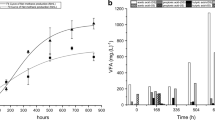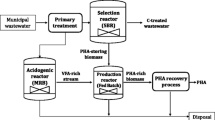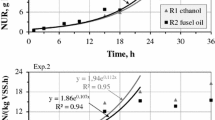Abstract
The purpose of this work was to assess the degradation of linear alkylbenzene sulfonate (LAS) in a horizontal-flow anaerobic immobilized biomass (HAIB) reactor. The reactor was filled with polyurethane foam where the sludge from a sanitary sewage treatment was immobilized. The hydraulic detention time (HDT) used in the experiments was of 12 h. The reactor was fed with synthetic substrate (410 mg l−1 of meat extract, 115 mg l−1 of starch, 80 mg l−1 of saccharose, 320 mg l−1 of sodium bicarbonate and 5 ml l−1 of salt solution) in the following stages of operation: SI—synthetic substrate, SII—synthetic substrate with 7 mg l−1 of LAS, SIII—synthetic substrate with 14 mg l−1 of LAS and SIV—synthetic substrate containing yeast extract (substituting meat extract) and 14 mg l−1 of LAS, without starch. At the end of the experiment (313 days) a degradation of ∼35% of LAS was achieved. The higher the concentration of LAS, the greater the amount of foam for its adsorption. This is necessary because the isotherm of LAS adsorption in the foam is linear for the studied concentrations (2 to 50 mg l−1). Microscopic analyses of the biofilm revealed diverse microbial morphologies, while Denaturing Gradient Gel Eletrophoresis (DGGE) profiling showed variations in the population of total bacteria and sulphate-reducing bacteria (SRB). The 16S rRNA gene sequencing and phylogenetic analyses revealed that the members of the order Clostridiales were the major components of the bacterial community in the last reactor operation step.






Similar content being viewed by others
References
Almendariz FJ, Meráz M, Soberón G, Monroy O (2001) Degradation of linear alkylbenzene sulfonate (LAS) in an acidogenic reactor bioaugment with a UIT Pseudomonas aeroginosa (M113) strain. Water Sci Technol 44(4):183–188
APHA-AWWA-WPCF (2000) Standard methods for the examination of water and wastewater, 20th edn. American Public Health Association/American Water Works Association/Water Environment Federation, Washington, DC, USA
Baena S, Fardeau ML, Labat M, Ollivier B, Thomas P, Garcia JL, Patel BKC (1999) Aminomonas paucivorans gen. nov., sp. nov., a mesophilic, anaerobic, amino-acid-utilizing bacterium. Int J Syst Bacteriol 49:975–982
Bolãnos ML, Varesche MBA, Zaiat M, Foresti E (2001) Phenol degradation in Horizontal-flow anaerobic immobilized biomass (HAIB) reactor under mesophilic conditions. Water Sci Technol 4:167–174
Cattony EBM, Chinalia FA, Ribeiro R, Zaiat M, Foresti E, Varesche MBA (2005) Ethanol and Toluene removal in a horizontal-flow anaerobic immobilized biomass reactor in the presence of sulfate. Biotechnol Bioeng 91:244–253
Chun J (1995) Computer assisted classification and identification of Actinomycetes. Ph.D. Thesis, University of Newcastle upon Tyne, Newcastle upon Tyne, UK
Denger K, Cook AM (1999) Linear alkylbenzenesulfonate (LAS) bioavailable to anaerobic bacteria as a source of sulfur. J Appl Microbiol 86:65–168
Dillalo R, Albertson OE (1961) Volatile acids by direct tritation. J Water Pollut Control Fed 33:356–365
Duarte ICS, Oliveira LL, Buzzini AP, Adorno MAT, Varesche MBA (2006) Development of a method by HPLC to determine LAS and its application in anaerobic reactors. J Braz Chem Soc 17:1360–1367
Ewing B, Hillier L, Wendl M, Green P (1998) Basecalling of automated sequencer traces using phred. I. Accuracy assessment. Genome Res 8:175–185
Fytianos K, Voudrias E, Mouratidou T (1998) The sorption—desorption behaviour of linear alkylbenzene sulfonate in marine sediments. Chemosphere 36:2067–2074
Garcia MT, Campos E, Dalmau M, Ribosa I, Sanchez-Leal J (2002) Structure-activity relationships for association of LAS with activated sludge. Chemosphere 49:279–286
Giles CH, MacEwan TH, Nakhwa SN, Smith D (1960) Studies in adsorption. Part XI. A system of classification of solution adsorption isotherms, and its use in diagnosis of adsorption mechanisms and measurement of specific surface areas of solids. J Chem Soc 4:3973–3993
Godon JJ, Zumstein E, Dabert P, Habouzit F, Moletta R (1997) Molecular microbial diversity of an anaerobic digestor as determined by small-subunit rDNA sequence analysis. Appl Environ Microbiol 63:2802–2813
Griffiths RI, Whiteley AS, O’donnell A G, Bailey MJ (2000) Rapid method for coextraction of DNA and RNA from natural environments for analysis of ribosomal DNA and rRNA-based microbial community composition. Appl Environ Microbiol 66:5488–5491
Kertesz MA, Kolbener P, Stockinger H, Beil S, Cook AM (1994) Desulfonation of linear alkylbenzene sulfonate surfactants and related compounds by bacteria. Appl Environ Microbiol 60:2296–3303
Khleifat KM (2006) Biodegradation of linear alkylbenzene sulfonate by a two-member facultative anaerobic bacterial consortium. Enzyme Microb Technol 39:1030–1035
Kimura M (1980) A simple method for estimating evolutionary rate of base substitutions through comparative studies of nucleotide sequences. J Mol Evol 16:111–120
Konig H, Stetter AO (1989) Archaeobacteria. In: Staley JT, Bryant MP, Fenning N, Holf JG (eds) Berger’s manual of systematic bacteriology. Williams and Wilkins, USA
Kudo Y, Nakajima T, Miyaki T, Oyaizu H (1997) Methanogen flora of paddy soils in Japan. FEMS Microbiol Ecol 23:39–48
Kumar S, Tamura K, Jakobsen IB, Nei M (2001) MEGA2: molecular evolutionary genetics analysis software, Arizona State University, Tempe, Arizona, USA. Bioinformatics 17:1244–1245
Lane DJ (1991) 16S/23S rRNA sequencing. In: Stackebrandt E, Goodfellow M (eds) Nucleic acid techniques in bacterial systematics. Academic, Chichester, UK, pp 115–175
Lie TJ, Pitta T, Leadbetter ER, Godchaux W, Leadbetter JR (1996) Sulfonates: novel electron acceptors in anaerobic respiration. Arch Microbiol 166:204–210
Lobner T, Toräng L, Batston EDJ, Schmidt JE, Angelidaki I (2005) Effects of process stability on anaerobic biodegradation of LAS in UASB reactors. Biotechnol Bioeng 89:758–765
Madigan MT, Martinko JM, Parker J (1997) Brock biology of microorganisms. Prentice Hall, Englewood Cliffs, NJ
Matthies C, Kubner CH, Acker G, Drake HL (2001) Clostridium uliginosum sp. nov., a novel acid-tolerant, anaerobic bacterium with connecting filaments. Int J Syst Evol Microbiol 51:1119–1125
Mogensen AS, Haagensen F, Ahring BK (2003) Anaerobic degradation of linear alkylbenzene sulfonate. Environ Toxicol Chem 22:706–711
Muyzer G, Wall EC, Uitterlinden G (1993) Profiling of complex microbial populations by denaturing gradient gel electrophoresis analysis of polymerase chain reaction—amplified genes coding for 16S RNAr. Appl Environ Microbiol 59:695–700
Nakagawa T, Sato S, Yamamoto Y, Fukui F (2002) Successive changes in community structure of an ethylbenzene-degradating sulfate- reducing consortium. Water Res 36:2813–2823
Nardi IR, Ribeiro R, Zaiat M, Foresti E (2005) Anaerobic packed-bed reactor bioremediation of gasoline contamined aquifers. Process Biochem 40:587–592
Nielsen AT, Liu WT, Filipe C, Grady L, Molin SO, Stahl D (1999) Identification of a novel group of bacteria in sludge from a deteriorated biological phosphorus removal reactor. Appl Environ Microbiol 65:1251–1258
Oliveira SWB, Moraes EM, Adorno MAT, Varesche MBA, Foresti E, Zatat M (2004) Formaldehyde degradation in an anaerobic packed-bed bioreactor. Water Res 38:1685–1694
Ripley LE, Boyle WC, Converse JC (1986) Improved alkalimetric monitoring for anaerobic digestion of high-strength wastes. J Water Pollut Control Fed 58:406–465
Saia FT, Damianovic MHRZ, Cattony EBM, Brucha G, Foresti E, Vazoller RF (2007) Anaerobic biodegradation of pentachlorophenol in a fixed-film reactor inoculated with polluted sediment from Santos-São Vicente Estuary, Brazil. Environ Biotechnol. doi:10.1007/s00253-007-0841-z
Saitou N, Nei M (1987) The neighbor-joining method: a new method for reconstructing phylogenetic trees. Mol Biol Evol 4:406–425
Sanz JL, Culubret E, Ferrer J, Moreno A, Berna SL (2003) Anaerobic biodegradation of linear alkylbenzene sulfonate (LAS) in Upflow anaerobic sludge Blanket (UASB) reactors. Biodegradation 14:57–64
Thompson JD, Gibson TJ, Plewniak F, Jeanmougin F, Higgins DG (1997) The ClustalX windows interface: flexible strategies for multiple sequence alignment aided by quality analysis tools. Nucleic Acids Res 24:4876–4882
Acknowledgements
This study was supported by Fundação de Amparo à Pesquisa do Estado de São Paulo (FAPESP). The authors acknowledge the grants received from Conselho Nacional de Desenvolvimento Científico e Tecnológico (CNPQ).
Author information
Authors and Affiliations
Corresponding author
Rights and permissions
About this article
Cite this article
Duarte, I.C.S., Oliveira, L.L., Saavedra, N.K.D. et al. Evaluation of the microbial diversity in a horizontal-flow anaerobic immobilized biomass reactor treating linear alkylbenzene sulfonate. Biodegradation 19, 375–385 (2008). https://doi.org/10.1007/s10532-007-9143-5
Received:
Accepted:
Published:
Issue Date:
DOI: https://doi.org/10.1007/s10532-007-9143-5




